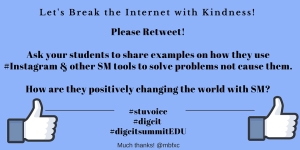Leading With Digital Citizenship: Let’s Break The Internet With Kindness
Although digital citizenship is not a new term or concept, the stories we generally hear tend to focus on safety and what our students should avoid. To me, digital citizenship is everyone’s responsibility and we need to carve out time and space for our students to actively do it. We need to switch the focus and highlight the positive ways our students are using social media. The more student examples we can share on what to encourage (instead of avoid), will help our students practice being safe, savvy and ethical.
Personally, I’m tired of reading scare-tactic posts on how students are using social media in inappropriate ways. After seeing this post, 8 Ways Kids Are Using Instagram to Bully on my digital citizenship (#digcit) Twitter feed, I had had enough of all the negative stories and I decided to flip the script and ask students to show us all the positive ways they use social media.
 Why aren’t the stories about the students I know and work with or the classrooms I follow on Twitter trending? Why don’t these stories make national headlines? Why does the media sensationalize the negative stories? Determined to break the Internet with kindness, I tweeted out my challenge asking students to tell a different story.
Why aren’t the stories about the students I know and work with or the classrooms I follow on Twitter trending? Why don’t these stories make national headlines? Why does the media sensationalize the negative stories? Determined to break the Internet with kindness, I tweeted out my challenge asking students to tell a different story.
The tweet got a lot of positive reaction and two members of my PLN took me up on my challenge and blogged about their experience. High school history teacher, Rachel Murat who also teaches a digital citizenship course had her high school students use the opportunity to examine how Students Spread Happiness to Combat Haters and Trolls. The students examined how to combat trolls and haters and created videos like Passing on Positivity.
My #digcit co-moderator and Mobile Learning Coach, Jennifer Scheffer had her @BHSHelpDesk students reflect on the positive ways they use social media, 12 Students Speak Out About Digital Citizenship. The big take-away is negativity breeds negativity and positivity breeds positivity. High school senior and Digital Citizenship Summit speaker, Timmy Sullivan shared how he uses social media:
“Clearly my experience leveraging social media (Twitter, LinkedIn, my blog) is taboo. But – dare I question the status quo again – why does it have to be? If we collectively divorce from the rhetoric of social media’s explicitly harmful nature, then we embrace the challenge to promote positive social media use in schools. Students can learn to leverage Twitter to build a global community of learners, use YouTube to share their content, connect with professionals via LinkedIn, and assert their voice through blogging. Through education, demonstration, and proactive conversation we can abolish cyber bullying- but we must first abolish our negative mentality.”
My hope is that all students, everywhere have opportunities to go beyond just talking about digital citizenship and have time to “do” and create positive solutions just like the students in Rachel and Jennifer’s classrooms. Instead of disengagement and fear, we need to promote empowerment. We need to create opportunities for our students to engage differently in a safe, savvy, and ethical manner and this needs to start early. Our youngest students need to use technology to connect and collaborate with an authentic global audience.
In order to improve online (and offline) culture and create safe, savvy and ethical “digital citizens,” we need to actively engage students by embedding digital citizenship into our everyday curriculum.
By not teaching digital citizenship in schools, we are also denying the opportunity to empower students to think and act at a local, global and digital level simultaneously. When we help our students positively change their local community (school, neighborhood, town, state, region), we help change other communities in the process.
Let’s make digital citizenship a verb and help our students bridge the physical gap between communities by connecting, collaborating, learning and doing digital citizenship together with other students and classrooms around the world. Let’s help our teachers and students become active citizens and enablers of positive change. Let’s focus on empathy and help our students humanize the person next to them, as well as across the screen.
In many ways, it’s like skipping stones and I hope you will be a part of the ripple effect by amplifying student voice in your classroom by showing the world how social media is used in positive ways. Like Timmy Sullivan said, let’s question the status quo and let’s break the Internet with kindness.
*Contact the @digcit_chat moderating team if you’d like to join us for our SnapChat Challenge and join us on Friday, May 6th for a Google Hangout on Air with educators and students sharing their experiences using SnapChat in the classroom.
